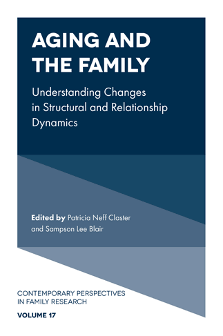
Index
Aging and the Family: Understanding Changes in Structural and Relationship Dynamics
ISBN: 978-1-80071-491-5, eISBN: 978-1-80071-490-8
ISSN: 1530-3535
Publication date: 25 February 2021
Citation
(2021), "Index", Claster, P.N. and Blair, S.L. (Ed.) Aging and the Family: Understanding Changes in Structural and Relationship Dynamics (Contemporary Perspectives in Family Research, Vol. 17), Emerald Publishing Limited, Leeds, pp. 293-301. https://doi.org/10.1108/S1530-353520210000017015
Publisher
:Emerald Publishing Limited
Copyright © 2021 Emerald Publishing Limited
INDEX
Note: Page numbers followed by “n” indicate endnotes.
- Prelims
- Chapter 1: Older Adults and Care: Reshaped Family Roles in Societal Change. A Comparative Study of Japan, South Korea, and Sweden
- Chapter 2: The Care of Older Adults in the Vietnamese Family and Related Issues
- Chapter 3: “Family Members Do Give Hard Times”: Home Health Aides’ Perceptions of Worker–Family Dynamics in the Home Care Setting
- Chapter 4: The Relationship Among Caregiving Duration, Paid Leave, and Caregiver Burden
- Chapter 5: Gender Differences in Grandparent Caregiving and Life Satisfaction of Older Jamaicans
- Chapter 6: Caregiving Grandmothers and Depressive Symptoms in South Korea
- Chapter 7: The Meaning of “Filial Piety” to Older Chinese Parents
- Chapter 8: Geography Matters. The Role of Non-cohabiting Elderly in the Individuals’ Perception about the Quality of Life in a Medium-sized Portuguese City
- Chapter 9: Being Women and Growing Old: Social Construction of Identities and Experiences of Aging Women in Contemporary Indian Families
- Chapter 10: Sexual Satisfaction in Long-term Marriages: Studying the Effect of Nonsexual Predictors in Old Couples
- Chapter 11: Parental Divorce and Social Support Networks in Younger and Older Adults: Extending Modes of Biographical Disruption
- Chapter 12: Social Network Experiences of Older Adults: Differences by Gender and Relationship Status
- Chapter 13: Marital Satisfaction in Older Adults
- Index